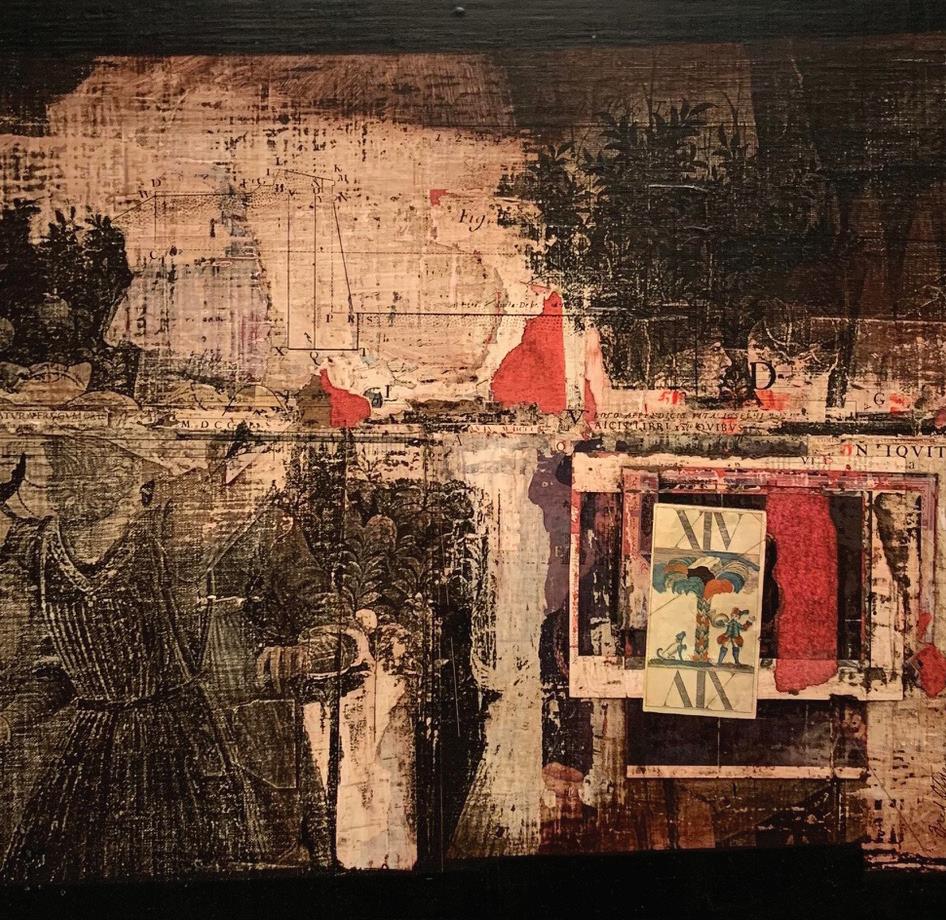
5 minute read
aRT Fred Otnes: A Collage
A R T Mix Master Mix Master
Fred Otnes: A COllAge at G1516 showcases career of Nebraska artist
By Jonathan orozco
Nebraska generally gets a bad rap in art history. If you were to ask a museum professional about famed Nebraska artists, they might only come up with a few names: multidisciplinary artist Ed Ruscha and fiber magician Sheila Hicks, and maybe Paul Chan if they really know about contemporary art. But there’s another artist who achieved great renown in his lifetime but whose name seems to only survive within niche art periodicals: Fred Otnes.
Gallery 1516 is currently presenting this artist’s oeuvre in a retrospective titled Fred Otnes: A Collage. Organized by the Museum of Nebraska Art in Kearney, which tends to emphasize artists from or with a connection to Nebraska, the exhibition focuses on Otnes’ later works.
Born in Junction City, Kansas, in 1925, Otnes expressed an interest in art early on. His family frequently moved around, but it was a period in Lincoln, Nebraska, that set him up for a career as a graphic designer-turned-artist.
In high school, an art teacher noticed his talents and arranged a visit for him to the city’s local newspaper, The Lincoln Journal. He was subsequently hired and worked after school and during the summer. His work was visual, focusing on cartoons, hand lettering, photography, drawing and engraving.
His tenure at the newspaper provided him with the language and technical skills any artist needs, skills that are revealed within his collage work in this exhibition. Though Otnes worked as a commercial artist for a few decades creating magazine covers, posters and images for postage stamps, he eventually turned to making art outside of the market — art for art’s sake, so to speak.
Generally speaking, these collage works are small, which is quite surprising since the compositions are commanding and monumental. Primarily coated in sepias and umbers of varying tones, Otnes shows he has a clear preference for muted colors. When he wants to get flashy by using reds or peaches, he ensures they are not overbearing. His aesthetic choices age his collages gracefully like the faded and weathered pages of an old tome — something he appears to take great pleasure in.
His materials also contribute to this sense of age, sometimes sourcing paintings and figures from other artists, but also from mathematical journals or older books. Otnes frequently juxtaposes a picture next to text or a geometric figure. He occasionally includes dimensional materials, such as dried flowers, textured fabric and even engraved stone, which approaches assemblage (a 3D collage).
There is also a direct connection to art history within his works. One collage titled “The Paris Workshop” alludes to the artists and cultures Otnes respects. The composition follows his standard color palette, with cutouts of historical paintings and architectural facades placed throughout.
To the center-right is a cropped cutout of a painting made by Diego Velázquez in 1653 named “The Infanta Maria Theresa aged 14.” At the bottom left is a triumphal arch, which is a type of monumental structure associated with ancient Rome. Toward the top is a horizontal band of architectural drawings.
What are we supposed to make of all this? It feels like a reexamination of canonical European art history and acts like a claim to art historical lineage, one that Otnes might have felt he was working within. Though, on a lighter note, collages like these are fun and lighthearted for art historians. Otnes might be asking them: “Well, how many of these images do you remember from your art classes?”
Other works are much more symbolic with their meaning, presenting narratives with recurring motifs and images. For example, a work titled “Silver Bird” is composed of a simple textured composition. The majority of the collage is non-representational, with the only figure being a relaxed bird perched on a beam constructed out of paper strips.
What looks to us as a very simple collage has been imbued with meaning by the artist. Birds





are a common motif for Otnes that represent creativity. They could also be taken as symbols of freedom and being unbound by the world. In this work, the bird is not caged, nor is it ready to take off flying.
All this is complicated with images of clocks toward the bottom of the composition. What could these cutouts mean? They could symbolize time, so Otnes may be expressing a desire to not waste time doing mundane tasks, communicating to his viewers that we should focus on what really matters in life.
The collages presented in this retrospective are only a primer for what Otnes has crafted. The accompanying catalog offers a deeper insight into his techniques and historical influences and is definitely worth a read.
Otnes died in 2015 in Westport, Connecticut, at the age of 89, far from his Midwest roots. We can only speculate if he remembered his time in Nebraska fondly.
Fred Otnes: A Collage will remain open until April 11 at Gallery 1516, located on 1516 Leavenworth St. Gallery hours range from Friday to Sunday, 11 a.m. to 5 p.m. by appointment. Visitors need to wear a mask and follow social distancing guidelines. For more information, visit gallery1516.org.
DIG INTO LEAD SAFETY
No need to get your hands dirty. See just how easy it is to ensure that your property is lead-safe.
Visit OmahaLead.org or call 402.731.3045 today.
OPS has surplused over 50 busses, trucks, 8 vans and we will be selling them at auction. This will be an online only auction and you must have a valid credit card to register. Payment will be taken online and all paperwork will be delivered at pickup 3/18 & 3/19 from 9:30 to 1:30pm.10% buyers fee will be added to your final purchase price and everything sold as is/where is. There are four hundred lots of office furniture, chairs & desks plus more up for auction as well. Check out times for those lots are March 15th, 16th & 17th 9:30am to 1:30pm. Great Plains Realty Auction Co www.gpsold.com Randy Fleming CAI, 402/210-4885







